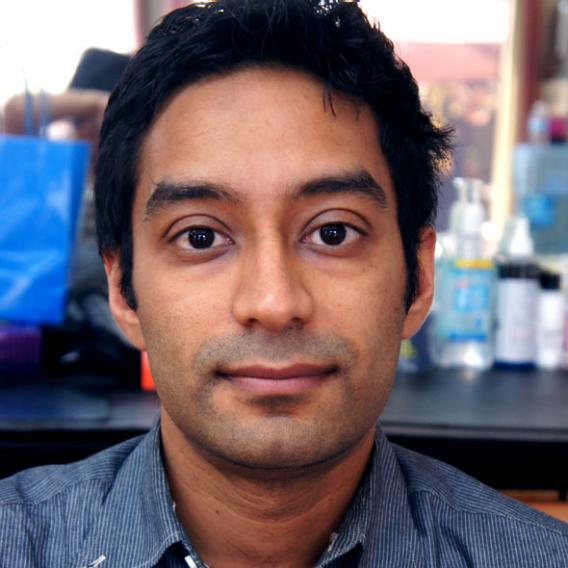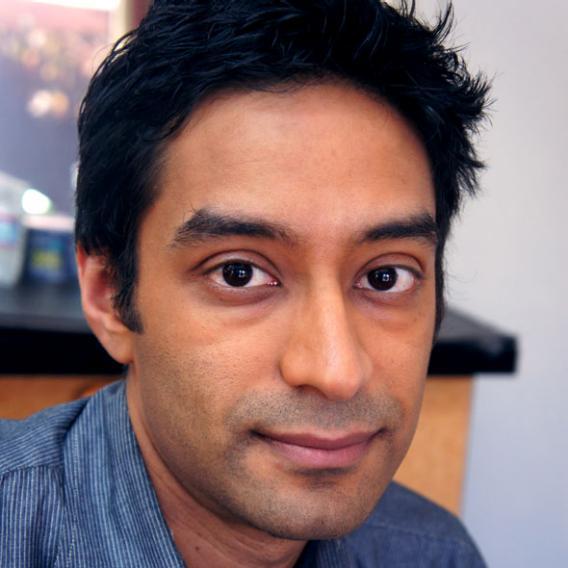“You know, you don’t really need makeup,” Rose Hill told me when we first met. We were at Hill’s studio in Los Gatos, Calif., where I’d come to see what a good makeup artist could do for a man (i.e., for me). Hill, who’s 60, has been doing makeup for film, television, theater, and commercial photography since she was a teenager. She’s worked on Bill Clinton, Barack Obama, every tech executive you can name, and Hugh Jackman—“my most favoritest person in the whole world,” she said as I thumbed through her portfolio.
Studying my face, Hill told me she didn’t see any obvious areas of concern. As I’d long suspected, I’ve got a good mug on my shoulders. Of course, she went on, nobody really needs makeup, not any more than one needs a fitted suit, a fancy car, or deodorant. But modern cosmetics are amazing. They remove blemishes, redness, signs of aging and fatigue, cuts or nicks from shaving, and most other indications that you’ve had a well-lived life. And they do so without looking like cosmetics. “When men think of makeup they think it’s heavy, that it’s unnatural, but we’re living in a new century,” Hill says. The most advanced cosmetics are designed to be photographed close-up with high-definition cameras, so they need to add pigment while leaving one’s pores visible. “Today’s makeup looks like skin,” Hill says. When I asked her what I’d look like with makeup, she was definitive: “You’ll just look better. It’s a big difference.”
She was right. This is what I looked like when I entered Hill’s studio:

Courtesy of Rose Hill
Mostly I looked OK. But there were some obvious places where my face could be improved. My forehead has a few light blemishes, and there are a few more under my eyes. I’d just shaved, and there were some red marks across my skin, plus some nicks. I had a just-visible pimple under my left eyebrow.
Over the next hour and a half, Hill put me through a series of makeup sessions. She applied “high-definition” makeup with an airbrush, a gun that sprays a very fine mist of color at your face, so fine that the dyes blend into your skin in a way that looks and feels like you have nothing on. Later on, she applied makeup the old-fashioned way, using brushes and sponges. Another time, she made me up using cheap, drugstore-counter foundation. After each session we stopped to photograph my face. Across the range of applications, I could see the good and the bad of makeup, from just enough to too much.
The bad makeup looked worse than no makeup, but the good makeup? It looked awesome. With some quick, easy-to-apply fine-tuning, I discovered that my pretty face can get even prettier. Here’s me looking best—this is after the first application of makeup, a light layer of HD foundation applied with an airbrush.

Courtesy of Rose Hill
There are very few differences between this picture and the one above. But the differences are enough—overall, with a light layer of foundation, my skin looks more even, less patchy, and less shiny. The red spots and blemishes are still visible, but they’re more subtle. I look more put together; the effect is roughly the same as if I’d combed my hair or put on a well-ironed shirt. Compared to wearing no makeup, with just a bit of color, I look like I took the time to bother about my appearance.
Which prompts the question: Why don’t I wear makeup all the time?
Men should wear makeup. I mean to say: Obviously men should wear makeup. It’s sort of crazy that we don’t, actually. Human beings have been adorning themselves since forever; evidence of the application of body paint dates back at least 50,000 years and is taken to be one of the first signs of modern human behavior. For nearly all that time, both men and women indulged in cosmetics. As recently as a few hundred years ago, it was common for upper-class men in Britain and France to wear rouge and powder. It was only around the turn of the 19th century that facial adornment for men began to go out of fashion—though at the same time, other cosmetic enhancements for men, especially hair-care products, took off. This makes little logical sense (though, granted, it’s folly to apply logic to fashion trends). If it’s seen as necessary for a modern man to comb and sculpt his hair, why isn’t he expected to make up his face, too?
Note that I’m not advocating for men to wear lipstick, blush, or other obvious signs of makeup. Red lips and cheeks and dark eyes are perceived as feminine because they cannily simulate female fertility—when a woman is ovulating, increased blood flow reddens her lips and cheeks, so lipstick and rouge are a way to mimic that effect. But skin tone isn’t sex-specific; studies show that when humans are presented with faces with even color distribution—faces whose skin tone looks the same from region to region—we find them more attractive than faces with uneven color. This has been shown in female and male faces. (The theory is that even color distribution is a token of youth, and youth, in turn, signals fertility.) Study after study has shown that people are disarmed by makeup—even though it’s obvious when a woman wears makeup, she’s judged as more attractive (by both men and women) than when she’s not wearing makeup.
It stands to reason that men could benefit from the same effect, especially if the makeup isn’t obvious. When you’re trying to impress someone—prospective dates, prospective employers, business associates, your spouse, your family, your employees—there’s no reason not to wear a little foundation. Actually I’d go further: You should wear makeup. We’re in a tough economy that rewards youth and beauty. We live in a world constructed of artifice—where not only magazine covers but even snapshots are now retouched, filtered, presented in the best light possible. You might admirably, justifiably recoil from this trend, you might yearn for a time when people had no trouble accepting a man for what he really looked like. But if there ever was such an age, it’s gone. We live in a Photoshop world. Think of makeup as a real-world digital-effects system. The foundation airbrush is like Photoshop for your face—armed with this gun, you can trick the world into loving you.
There are signs that some men are beginning to understand this. Over the past decade in South Korea, makeup for men has become a culturally accepted fact of life. The conservative, male-dominated society was prompted to embrace male cosmetics in part because makeup worked—men who wore makeup found that it gave them a leg up romantically and in employment markets. Hill says she’s heard the same thing from some of her clients. “I’ve done makeup on corporate executives for photos, and then they see how they look, and they’ll call me to ask if I can order makeup for them,” she says. “Especially if they’re single—they just feel better about themselves and look better.” Over the past few years the market for skincare products for men has been booming, though cosmetic companies have been wary of products that resemble traditional makeup. Lately that seems to be changing. Marc Jacobs recently unveiled a line of makeup for men, including a concealer to cover up bags under your eyes. But even he’s wary of advocating for foundation for men—that seems to be deemed too feminine.
I can see why. When it’s overdone, on a man, makeup can look very strange. Here’s me with two colors of foundation that Hill applied on my face by brush. This application covers up many blemishes and red marks, but to me it looks too pretty.

Courtesy of Rose Hill
This one is even worse: After a quick application from a bottle of Revlon foundation—that is, not the high-definition stuff designed to look like you’re not wearing anything—I look way too orange, like I’ve been colorized.

Courtesy of Rose Hill
But I found that it’s easy to avoid this fate. As you know, I’m a sucker for technology, so near the end of our session, I asked Hill if I could use her airbrush on my face. She showed me how to use it—hold it like a pair of chopsticks, press the button to shoot. It was totally easy and fun, very much like using the airbrush tool in any photo editing software. Starting with a clean face, I managed to make myself up in about three minutes’ time. Later that day, I bought an airbrush kit online for about $100, and I’ve since tried it out a couple times at home. I think I’m good at it—I can quickly do my face in a way that improves the skin without looking obviously touched up.
I’m married and I have a job—though we’ll see what happens after this article runs—so I don’t think I’ll be wearing makeup every day. But if I ever need an extra boost, the airbrush will be right there waiting for me. Here’s my face with a bit of airbrushing by yours truly. This is not a face you can easily refuse.

Courtesy of Rose Hill